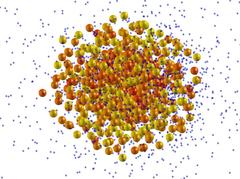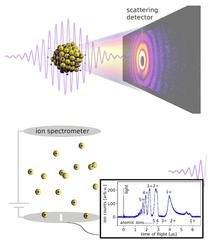URL: https://www.desy.de/news/news_search/index_eng.html
Breadcrumb Navigation
DESY News: FLASH observes exploding xenon nanoparticles
News
News from the DESY research centre
FLASH observes exploding xenon nanoparticles
A team of researchers led by Daniela Rupp from the Technical University of Berlin has been using DESY’s X-ray laser FLASH to study the ultrafast, light-induced explosion of nanoparticles made up of xenon. Studying these so-called xenon clusters provides new insights into the fundamental interaction between intense radiation and matter, as the scientists report in the journal Physical Review Letters.

Exploding xenon cluster with liberated electrons (blue dots). Credit: Thomas Fennel/University of Rostock
The scientists then fired ultrashort, high-intensity pulses of laser light from FLASH at these tiny xenon nanoparticles, roughly 400 nanometres (millionths of a millimetre) across, whereby the radiation reached intensities of up to 500 trillion watts per square centimetre for a few trillionths of a second. By comparison: the intensity of sunlight striking the surface of the Earth is around 0.1 watts per square centimetre. The bright pulse of radiation liberated numerous electrons from the xenon atoms in the cluster, creating a plasma – a hot gas consisting of electrically charged atoms, so-called ions, with electrons racing around between them.

During their investigations, the scientists also detected a previously unnoticed heating effect within the plasma: “Every time an electron is recaptured by a xenon atom, it releases energy to the surrounding plasma,” explains Rupp. “As a result, those xenon ions that do not recombine with electrons receive a larger proportion of the energy in the end – the electrons heat up the ions, so to speak.”
“The results are in excellent agreement with theory,” explains Thomas Fennel, a theoretical physicist at the University of Rostock. “When ‘recombination heating’ is added into the theoretical model, it precisely describes our observations. In this study, theoretical and experimental physics complement each other in an excellent way.”
In addition to DESY, the Technical University of Berlin and the University of Rostock, the La Trobe University in Australia, the US research centre SLAC in California, the Helmholtz Centre Berlin, the University of Münster and the Argonne National Laboratory in the USA were also involved in this work.
Reference:
Recombination-enhanced surface expansion of clusters in intense soft X-ray laser pulses; Daniela Rupp, Leonie Flückiger, Marcus Adolph, Tais Gorkhover, Maria Krikunova, Jan Philippe Müller, Maria Müller, Tim Oelze, Yevheniy Ovcharenko, Benjamin Röben, Mario Sauppe, Sebastian Schorb, David Wolter, Rolf Mitzner, Michael Wöstmann, Sebastian Roling, Marion Harmand, Rolf Treusch, Mathias Arbeiter, Thomas Fennel, Christoph Bostedt, and Thomas Möller; Physical Review Letters, 2016; DOI: 10.1103/PhysRevLett.117.153401



